The Columbia River Crossing highway-rail expansion project died with a whimper two weeks ago, and Portland’s low-car transportation advocates have just started to rub their eyes and organize their celebrations.
With this big project in the rear-view, we want to ask the BikePortland community what the Portland region has learned.
To inspire your thoughts (and further actions) here’s a roundup of some ways the Portland area is adjusting to a post-CRC reality:
Celebrations: The meme factory workers at OMG CRC WTF are organizing a celebration July 22 at Velo Cult to recognize the victory and talk about what’s next. There’s also what looks like quite a crowded happy hour this Friday at Produce Row.
Ministry of truth: Anti-CRC activist Dan Kaufman has made an interesting list of myths he says can be busted, now that project planners are no longer being paid to push them (links below are my own):
- The I-5 bridge is in immediate need of replacement. ODOT documentation from 2005 states that with proper maintenance the I-5 bridge has another 50-60 years of life.
- I-5 must be widened through Portland. Urban freeways are on the way out. Portland already has given up too much valuable real estate for passersby.
- Vancouver residents want light rail. Actually, they might take it if it were free, but they have not yet been offered a project they are willing to fund.
- Seismic issues are our most pressing transportation safety and infrastructure concern. With daily automobile-induced carnage and congestion, they are simply not.
- Most of the project cost was the bridge or the light rail. Actually the largest cost was the new freeway interchanges.
- The CRC was an economic benefit as a works project. Any short-term jobs benefit was outweighed by the loss of permanent (and potential) jobs near the project site and upriver. If we are looking for a WPA project, we can do a lot better and not put the tab on the backs of working-class commuters.
- The new bridge was an improvement for cyclists and pedestrians. If you think passage similar to I-205 is an improvement, perhaps, but not when you consider that they cut a significant portion of the bike/ped access over North Portland Harbor.
Back to business: The Columbian business section’s retrospective on the end of the project includes this from downtown Vancouver real estate owner Craig Angelo: For better or worse, downtown Vancouver is now no longer waiting for a $3 billion shadow to drop over it. “Every individual and business that was waiting for a decision on the new bridge now knows their fate. They should sit back, take a deep breath and plan accordingly to resume their lives.”
Will the next CRC be better? On Portland Transport, Scott Johnson says government officials and the public in general are moving away from two key forces behind highway projects: suburbanization and trade unions.
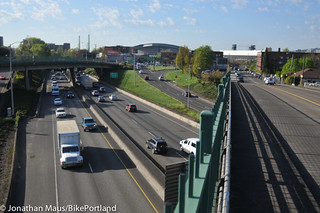
is now the only major active highway expansion project
in Portland.
How will this affect ODOT’s Rose Quarter plans? On Blue Oregon, Chris Smith wonders if Oregon’s transportation department could redirect bonding capacity intended for the CRC to instead pay for highway expansion near the Rose Quarter. But for all its problems, the bill authorizing Oregon’s borrowing for the CRC was very explicit that the money could only be used for that project, and only if the State of Washington acted to fund it. However, it’s definitely the right time to ask whether the Rose Quarter plans need a re-grounding in political reality.
Have engineering firms marginalized themselves? When we reported yesterday on the creation of a new regional transit advocacy group, several readers immediately pointed out, correctly, that its founder’s current and past employer stood to get big benefits from the CRC. (Another reader noted that the group also has tentative support from one of the CRC’s most vocal opponents.) Has the long fight over this project done permanent damage to the companies involved with it?
What role did urbanists play? Here’s a question I haven’t seen asked yet. Because it was a near-party-line vote by Washington Senate Republicans that finally killed the CRC, many people are saying that conservatives killed the CRC singlehandedly. I’m not so sure. In retrospect, although Metro President David Bragdon and Portland Mayor Sam Adams signed off on the compromise project in 2010, the price they exacted for their signatures (tolling and light rail) were exactly the terms that ended up alienating Washington conservatives. No, Bragdon and Adams didn’t walk away from this project when they could have. But anti-highway pressure from their constituents forced them to take positions that turned out to be poison pills.
In memoriam: Columbian reporter Eric Florip wrote an obituary for the project: “In 2008, the CRC wedded light rail in an arranged marriage. The two remained committed to each other until the end, but never took their planned honeymoon to Clark College.” The newspaper even put together a video to mark the occasion:
We’d love to see some further funeral orations below.


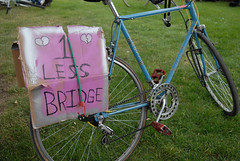
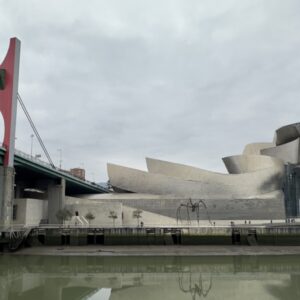
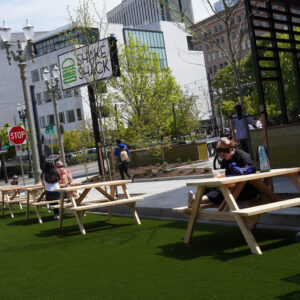

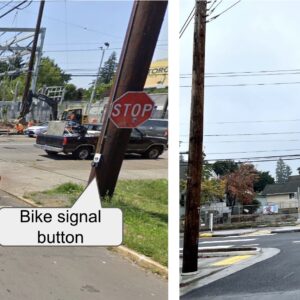
Thanks for reading.
BikePortland has served this community with independent community journalism since 2005. We rely on subscriptions from readers like you to survive. Your financial support is vital in keeping this valuable resource alive and well.
Please subscribe today to strengthen and expand our work.
Despite this wonderful victory, I’ll never forget our Oregon politicians who let us down when the outcome was less certain… Governor Kitzhaber, Tina Kotek, and Chip Shields, to name a few. They were on the wrong side of this dead freeway, and I’m incredibly happy that they didn’t have their way, in the end. Too bad we burned, what, 160 million on this boondoggle, even with nothing done? All those staffed PR tents at neighborhood events… I’m so glad this is over.
And let’s not forget Jules Bailey, who voted with the machine, then ignored email from constituents questioning his decision.
Jules Bailey is a traitor. He voted for the NIKE tax give away and most recent for the corporate welfare bill. He does not belong in government.
can’t see the “quite a crowded happy hour” page because Facebook registration is required…
I like the current I-5 crossing way more than I like the I-205 crossing… the only issue with the I-5 crossing is the route to and from… even the I-205 route isn’t great but it’s more obvious and direct…
Well, the bridge sidewalk is a little narrow, you must admit. A bit harry when you are pulling your kids in a trailer.
I look forward to the Common Sense Alternative becoming popular, now that the CRC is dead
I would love for PBOT/ ODOT to rally an get a Broadway Bridge type pedestrian path upgrade on the Interstate Bridge in the next 3 years…
Why? If the 205 bridge were the length of I-5 it would be a slam dunk for the 205. It’s length (and the median location) are the only real negatives. It’s connectivity is exponentially more straight forward and easily accessed.
I’d love to see something like the I-90 MUP in Seattle. Similar to 205, but off to the side, so doesn’t feel like you’re in a noisy wind tunnel of traffic.
Remember those busted myths for when the CRC2 pops up.
I think it’s a good idea to sell bonds to invest in capital infrastructure projects. I think it’s a bad idea to invest in new auto-centered capital infrastructure projects, however, because in general, the automobile-centric transportation system is built-out and complete, as measured by the simple criteria that you can now get anywhere from anywhere using a car, without any noticeable gaps in the network. Your actual travel speed may vary, as with all other modes, due to a variety of factors including the number of other users of the system.
Therefore, it would seem logical that our next step would be to float an equivalent amount of bonding capacity, and invest it in the near term ENTIRELY on building out (seeking to complete) the bicycle, pedestrian and transit networks in this state.
You make some good points.
Now, if all you had was dialup instead of a cable modem, would you want more capacity?
I am so thankful that Jonathan’s blog coaxed Ron Buel into sharing his perspective on the political shenanigans going on behind the scenes. Here:
http://bikeportland.org/2013/02/28/as-crc-rumbles-forward-major-advocacy-groups-sit-on-the-sidelines-83284#comment-3801482
and here:
http://bikeportland.org/2013/02/28/as-crc-rumbles-forward-major-advocacy-groups-sit-on-the-sidelines-83284#comment-3801575
Not dead, just delayed. The next version will be a bare bones car-centric model which the WA legislature will likely support. The “victory” that many are celebrating is about eliminating public transit from the equation. Just what WA wanted. Party on!
Let them try. Without LRT there’s no Fed funding, not now, not tomorrow. Joe Cortright was dead on, this was the last stand for CRC backers and then blew it. We’ll stay ever vigilant, but there won’t be a ten lane freeway expansion in Portland’s future ever again.
You are all very erudite in your analysis. Then entire thing went down in the Washington State Senate because of a Microsoft Millionaire named Rodney Tom. He is a guy who switches parties based upon which party holds the national presidency but has recently become a Republican again and in so doing, got himself the the role of majority leader.
It’s just a game of chicken up here and you can expect some stripped down version on the November 2014 ballot. Keep your powder dry. I’ll be working hard up here too.
Well put…the Oregon readers may not have been following closely some of the odd Olympia party politics that really helped make the CRC impossible to fund using “standard political gamesmanship” that usually allows auto transportation projects to be funded. Not sure how much longer this marriage will last up here.
Democratic legislators will never agree to a bridge without light rail. Many, if not most, washington republican will never back down from their insanely fanatical anti-public transportation stance. This is my kind of gridlock!
Because public transportation is so great in Democratic Seattle?
So, seismic risk is only real when we want to talk about how handy cargo bikes will be for disaster relief after the big one? There is something deeply f’ed up about that sentiment.
There is exactly one bridge in the region up to current seismic standards (the new Sauvie Island bridge). And even that doesn’t guarantee it won’t fall down during a massive earthquake.
If the reasoning is taking seismic risk seriously, we should worry about the hundreds of Oregon schools that aren’t up to seismic standards, as well as focusing our resources on seismic retrofits. Retrofitting the existing I-5 spans would cost about 5% of the cost of the CRC, allowing scores of other bridges to also be retrofit.
The new Sellwood Bridge as well as the TriMet LRT/bus/bike/ped bridge will also be up to current seismic standards.
Ok…who will now fill the vacuum with the Plan B …to build a 1960s project or a project for the future…I worry that in all the celebrations the forces that only wanted 18 lanes for Hayden Island will be the ones prepared to act and secure their transportation project.
PS. Portlanders if you really care about your legacy regarding highways…please do what you can to close the Hayden Island ramps from I-5 and move them south off of the interstate.
Not sure how i ended up at this video: http://couv.com/issues/clark-county-today/cct-peterson# but it is a refreshing perspective and one that gives me hope that v 2.0 will be an entirely different project. As for what we learned, I would say, not a whole lot, considering that it almost was built if not for some uncooperative Washington State legislators
I’m with Barney and Brad, I don’t think this is the end of the road, just a fork…
I think we should build a bridge just for transit, bicycles, and pedestrians like the Tri-Met bridge currently being constructed.
As for the Washingtonians defeating the CRC, here is the next iteration:
http://www.columbian.com/news/2013/jul/09/thursday-open-house-focus-bridge-alternatives/
The conservatives up here always wanted a new bridge, just an auto oriented bridge to promote more sprawl in Clark County. Read the link above, this is the next phase of the fight.
I heartily second the “everything but cars” new bridge. Although the current bike facilities are sub-par, I decided several years ago that I would not be held hostage to a 12-lane bridge just to get new transit and bike lanes, which would be an iffy improvement anyway.
I’d also note that while my current state (Washington) was the one who hit the final blow, the work by citizens and groups like the Coalition for a Livable Future (and the BTA and OLCV and grassroots groups) managed to keep the CRC from being fast-tracked for years.
They’ve been trying to get CRC bills passed for many sessions, and thanks to the hard work of various groups (and the work of legislators like Rep. Katie Eyre and Rep. Jefferson Smith) it took many years to pass the bill they finally passed in 2013.
Moreover, even if Washington provided funding the CRC wasn’t yet a done deal. CLF and the Northeast Coalition of Neighborhoods and the Northwest Environmental Defense Center and others have had a pending NEPA lawsuit against the project, and thanks to the work of Joe Cortright and others too numerous to thank the Oregon bill required jumping through the hoop of a Treasurer’s office finding – something the project may not have been able to do.
Years and years of hard work by scores of courageous Davids went into this win against Goliath. Congrats to all, including the urbanists.
I do think seismic risk SHOULD be one of our most pressing transportation concerns, if it isn’t.
But I agree with Evan Manvel that if we’re going to do something about it, the I-5 Columbia River bridges shouldn’t be the highest priority. Even among major bridges, we would do well to take care of the Marquam and Fremont first. (Of course in the case of the Marquam, the best option might be to simply remove it and rename I-405 to I-5, but that’s another topic).
Ditto the renaming.
We could probably satisfy the labor unions, contracting industry giants, the Feds, the planners, and the urbanists, with a new massive project to bury I-5 underground between the two 405 interchanges, and re-take the waterfront for the city.
Excuse me, I’m off to buy up light industrial buildings on the East Side.
Judging by the number of progressives who are patting themselves on the back over the CRC’s demise, I’d say the answer to the question, “Did we learn anything?” is “Not really.”
Seriously, all these folks who are hosting victory celebration happy hours — did they all secretly know that the WA senate would torpedo the project at the last minute? Was it part of their grand, clever strategy? Really? Because I’m pretty sure they were all on this site a couple months ago screaming bloody murder when their “progressive” electeds in the OR legislature were voting FOR the CRC. Get your stories straight, people — let’s learn from history instead of trying to rewrite it.
Pretty strong case, RJ. So what lessons would you suggest instead?
RJ, I don’t see this as a chance to party because, ostensibly, we kicked some a$$ (we didn’t–we had ours handed to us by Dem legistlators and governors in both states); rather, we celebrate because we narrowly missed being bulldozed into a horrendously worse future. Have you never seen sports fans losing their sh!t in a sports bar? There you go.
RJ- The work to stop the CRC has been cross-state for many years; with progressives in Oregon and Washington talking to and working with those who opposed the CRC in Oregon and Washington for other reasons. We’ve long known there were many ways to kill the CRC, and taken a variety of tactics, messages, etc. Our collective research and strength – finding things out and sharing them to the various audiences we’re most compelling messengers to – has been stronger than it would have been should we have been alone. We’ve long known that the conservatives were more willing to say no to this than the progressives, and the hope was to get enough progressive votes to go along with the conservatives to form a majority. And for years, that worked – which contributed to its demise. Washington’s conservatives dealt the last blow, but it’s completely possible without progressives fighting it the project would have been approved years ago. It’s hard to do counterfactuals.
In the end, this hugely wasteful and polluting project that would scar the region is dead. For everyone, whether they worked on it or not, whether they were key to its demise or not, that’s reason enough to celebrate.
“this hugely wasteful and polluting project ” – so, more so polluting that the current air quality condition when traffic backs up due to delays, etc? Or more polluting than existing roadway runoff when traffic sits and there’s more petroleum distallate drippage on the highway? Or more polluting when paint chips and rust flake off the bridge into listed species habitat within the Columbia? More polluting than the amount of resources they currently use to band-aid all the issues with the existing span (thousands of gallons of paint, steel and concrete)???
Don’t kid yourself. The existing structure IS an issue to the environmental. Not to mention a HUGE safety concern. Did you know there are several structural steel members on the bridge now than are broken or rusted through? The temporary patches that have been applied have outlived their lifespan… yeah, let’s keep the existing bridge. It’s WAY better for the environment and the safety of the traveling public… ALL travelling public.
Yes, actually the new project would be vastly more polluting than today’s congestion. History has shown over and over and over again that newly constructed or expanded freeways have a tendency to fill up quickly, leaving us with even more pollution than before. Even if the new freeway isn’t congested, the increase in traffic creates more pollution than before, and once it does get congested (which usually just takes a few years) then things get worse yet.
Actually, it might not even get that far. The existing bridges are NOT the bottlenecks — the nearby freeway interchanges are. Anyone with half a transportation degree can see that streamlining I-5 from North Portland through Vancouver would just push the bottleneck further down into central Portland, where it would create the same amount of pollution or even more.
the really scary thing is, it would end up causing more pollution right smack in the middle of a dramatically more dense are. Likely increasing the death toll for benzine poisoning, cancer and other issues that are related to automobile pollution.
what about the CSA? http://vimeo.com/22915646
CSA! CSA! CSA! Hell yeah CSA! CSA! CSA! CSA! Hell yeah CSA! CSA! CSA! CSA! Hell yeah CSA! CSA! CSA! CSA! Hell yeah CSA! CSA! CSA! CSA! Hell yeah CSA! CSA! CSA! CSA! Hell yeah CSA! CSA! CSA! CSA! Hell yeah CSA! CSA! CSA! CSA! Hell yeah CSA! CSA! CSA! CSA! Hell yeah CSA! CSA! CSA! CSA! Hell yeah CSA! CSA! CSA! CSA! Hell yeah CSA! CSA! CSA! CSA! Hell yeah CSA!
“…did they all secretly know that the WA senate would torpedo the project at the last minute?”
Yes, we did. But it wasn’t a secret.
I learned never to trust another elected official again – not even the ones I “like”.